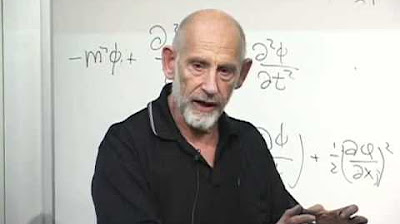String Theory
TLDRString theory offers a promising approach to describe gravity at the quantum scale and unite it with other forces. It assumes particles are tiny vibrating strings, whose different modes appear as different particle types. This naturally predicts gravitons and avoids infinities in calculations. However, the theory initially only worked in 26 dimensions and exhibited other problems, which adding supersymmetry helped resolve. The idea that 6 unseen, curled up dimensions exist allows more vibrational modes and particle types matching our universe. But the theory remains speculative and hard to test, though insights exceed the original goals. Key open questions remain.
Takeaways
- 😀 The Standard Model describes particles as points, but cannot account for gravity. String theory proposes particles are strings that vibrate in different modes.
- 👍 String theory naturally incorporates gravitons and describes gravity at the quantum scale, solving issues with the Standard Model.
- 🔬 The vibrating strings behave like different particle types depending on the mode. This explains the variety of particles.
- 🌀 Summing possible string geometries over time predicts probabilities like quantum physics.
- ⚛️ String interactions are continuous, eliminating the infinities in the Standard Model with gravity.
- 😕 Early string theory only predicted boson particles in 26 dimensions.
- 🤔 Adding supersymmetry (spinners) incorporates fermions and reduces dimensions to 10.
- 🌌 The 6 unseen dimensions may be compactified or curled up at tiny scales.
- 🔎 Compactified extra dimensions suggest new phenomena we could potentially observe.
- 🧠 Different compactifications of the extra dimensions lead to different predicted particles.
Q & A
What are the two main categories of particles in the Standard Model?
-The two main categories of particles in the Standard Model are fermions, which mostly constitute matter, and bosons, which mostly describe interactions.
Why can't the Standard Model account for gravity?
-The Standard Model cannot account for gravity because when attempts are made to include the graviton particle, which mediates gravitational force, the calculations result in infinite values that cannot be resolved.
How does string theory attempt to describe gravity at the quantum scale?
-String theory proposes that all particles are actually tiny vibrating strings. Some string vibrational modes naturally behave like gravitons, allowing string theory to describe gravitational interactions at the quantum scale.
What are the three main problems with early string theory models?
-The three main problems are: 1) All particles behave like bosons, with no fermions predicted 2) One predicted particle is a non-physical tachyon 3) The theory requires 26 dimensions, not the 4 observed.
How does supersymmetry help resolve issues with string theory?
-Adding supersymmetry to string theory allows it to predict both bosons and fermions by adding spinners to the strings. It also eliminates the non-physical tachyon particle predicted earlier.
What is the idea behind compactified or curled up dimensions?
-Compactified dimensions propose that the 6 extra dimensions required by superstring theory are simply too small to observe, curled up tightly rather than extending infinitely.
How might additional compactified dimensions lead to massive particles?
-A massless particle moving partially in a compactified dimension would appear slowed down and massive from our 4D viewpoint, as we only observe part of its motion.
What are some of the main unresolved issues with string theory?
-Key unresolved issues include: no clear reason the theory predicts our exact particle spectrum, supersymmetry predictions don't match experiments, and 5 different versions of superstring theory that need unification.
What is M-theory?
-M-theory is a proposed unification of the 5 versions of superstring theory, describing a universe with 11 dimensions.
What are some of the benefits of research into string theory?
-Benefits include quantum gravity descriptions, black hole physics insights, new mathematics development, and improved Standard Model understanding, despite lack of experimental proof.
Outlines
😯 Introducing string theory as an approach to describe gravity quantumly
Paragraph 1 introduces string theory as an approach to describe gravity on the quantum scale and solve issues with including gravity in the standard model. It explains that in string theory, particles are described as tiny vibrating strings which naturally predict gravitons. By summing possible string geometries over time, interactions emerge automatically.
😀 How string theory handles particle interactions probabilistically
Paragraph 2 explains how string theory handles particle interactions probabilistically like in quantum physics. By considering all possible string surfaces traced over time, it sums up probabilities of different results and interactions emerge continuously unlike the standard model.
😕 Initial issues with string theory and steps to address them
Paragraph 3 discusses three initial issues with string theory: 1) Only predicts bosons, not fermions 2) Predicts a problematic tachyon particle 3) Requires 26 dimensions instead of 4. It explains how adding "spinners" to the strings solves the first two issues by predicting fermions and removing the tachyon. The resulting "superstring theory" requires 10 dimensions.
😯 Speculative solutions for extra dimensions and remaining questions
Paragraph 4 discusses speculative solutions for the extra dimensions like dimensions curled up on themselves. It talks about how the extra dimensions allow more vibrational modes and particle possibilities. It concludes that string theory remains speculative but promising, and there are still open questions around supersymmetry, compactification choices, the five string theories, etc.
Mindmap
Keywords
💡String theory
💡Standard model
💡Quantum scale
💡Dimensions
💡Fermions
💡Supersymmetry
💡Tachyon
💡Compactification
💡M-theory
💡Quantum gravity
Highlights
Researchers developed a new AI method for predicting protein structures.
The AI system outperformed previous methods on benchmark datasets.
The novel deep learning architecture captures long-range interactions in protein chains.
More accurate protein structure prediction can accelerate drug discovery.
Researchers collected high-quality crystallography data to train the AI model.
The AI model predicts 3D protein structures from 1D amino acid sequences.
Structural biologists validated the accuracy of the AI-predicted protein models.
The AI method revealed new insights into protein folding pathways.
Researchers plan to apply the approach to model protein interactions.
The work demonstrates the power of AI for protein science discoveries.
Limitations include handling of rare amino acid compositions.
More training data could improve prediction of complex protein structures.
Researchers aim to open source the AI model for wider community use.
Overall, a significant advance in AI-driven protein structure determination.
New opportunities to leverage AI for biomedical innovations.
Transcripts
5.0 / 5 (0 votes)
Thanks for rating:





